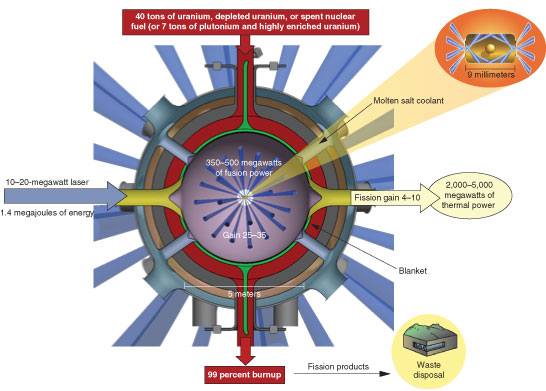CONTROVERSES  NUCLEAIRES !
NUCLEAIRES !
La FUSION?! NUCLEAIRES !
NUCLEAIRES !Nouvelles de la "fusion inertielle"
juin 2010
 NUCLEAIRES !
NUCLEAIRES !|
https://str.llnl.gov/  LIFE (Laser Inertial Fusion Energy) is an approach to pure fusion energy as well as a once-through, closed nuclear fuel cycle. A LIFE power plant comprises a solid-state laser system and a fusion target chamber that can be surrounded by a subcritical fission blanket. The balance of the plant includes a fusion target factory, a heat exchanger, and other systems. The LIFE engine starts with a 10- to 20-megawatt diode-pumped solid-state laser system to provide about 1.4 megajoules of energy. Deuterium–tritium fusion targets are injected at 10 to 15 times a second into the center of a 2.5-meter-radius fusion chamber. The laser beams ignite the fusion targets to obtain energy gains of 25 to 35 and fusion yields of 35 to 50 megajoules of energy, thereby creating 350 to 500 megawatts of fusion power (about 80 percent in the form of fusion neutrons, with the rest of the energy in x rays and ions). Each fusion target generates about 1019 neutrons. The fusion neutrons can also drive fission reactions in a surrounding subcritical fission blanket. The target chamber’s structural steel wall is made of low-activation oxide-dispersion-strengthened ferritic steel coated with 250 to 500 micrometers of tungsten to provide resistance to damage by high-energy fusion neutrons and the high temperatures resulting from absorption of the x rays emitted from the LIFE targets. The fusion neutrons pass through the first structural steel wall to a layer of metallic pebbles, which moderate the energy of the fusion neutrons and generate 1.8 neutrons for each neutron they absorb. (...) |
The moderated neutrons have a much lower energy
spectrum than the fusion neutrons and are ideal for generating fission
energy. These neutrons strike the 1-meter-thick subcritical fission blanket
containing radiation-damage-resistant fission-fuel pebbles made from materials
such as spent nuclear fuel and depleted uranium. The fuel pebbles absorb
the neutrons to produce fissile material and drive fission reactions, which
release heat to drive turbines. The pebbles are immersed in a molten salt
that carries away heat and produces tritium. The tritium can then be harvested
to manufacture new fusion targets.
Voir également: * Fusion contrôlée: après ITER voilà HiPER! (Futura Sciences) * Un extrait de "Pour la Science" de juin 2010: (...) Une centrale LIFE fonctionnant 24 heures sur 24 utiliserait environ 90.000 cibles par jour. (...) Bien entendu, il est impossible de prévoir la situation énergétique dans 20 ans. Il se pourrait que l'on ait besoin, plus que jamais, d'énergie produite par fusion thermonucléaire. Mais il se pourrait aussi qu'une percée de l'énergie solaire, éolienne ou d'une autre forme d'énergie fasse apparaître, par comparaison, la fusion comme trop coûteuse ou difficile à domestiquer (...). La fusion n'est qu'une voie possible parmi d'autres, et il lui faudra plusieurs décennies avant qu'elle porte ses fruits. L'ignition est peut-être proche, mais l'ère de l'énergie disponible à volonté ne l'est pas. |